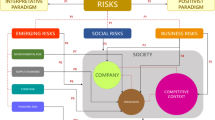Abstract
Goal, Scope and Background
The importance of the social dimension of sustainable development increased significantly during the last decade of the twentieth century. Industry has subsequently experienced a shift in stakeholder pressures from environmental to social-related concerns, where new developments in the form of projects and technologies are undertaken. However, the measurement of social impacts and the calculation of suitable indicators are less well developed compared to environmental indicators in order to assess the potential liabilities associated with undertaken projects and technologies. The aim of this paper is to propose a Social Impact Indicator (SII) calculation procedure based on a previously introduced Life Cycle Impact Assessment (LCIA) calculation procedure for environmental Resource Impact Indicators (RIIs), and to demonstrate the practicability of the SII procedure in the context of the process industry in South Africa.
Methods
A framework of social sustainability criteria has been introduced for the South African process industry. The social sub-criteria of the framework are further analyzed, based on project and technology management expertise in the South African process industry, to determine whether the criteria should be addressed at project or technology management level or whether they should rather form part of an overall corporate governance policy for new projects and technologies. Furthermore, the proposed indicators for criteria that are considered appropriate for project or technology evaluation purposes are constrained by the type of information that is available, i.e. the calculation methodology relies on the availability of regional or national social information where the project will be implemented, as well as the availability of project- or technology-specific social information during the various phases of the project or technology development life cycle. Case studies in the process industry and statistical information for South Africa are subsequently used to establish information availability for the SII calculation procedure, demonstrate the SII method together with the RII method, and determine the practical use of the SII method.
Results and Conclusion
The case studies establish that social footprint information as well as project- and technology social data are not readily available in the South African process industry. Consequently, the number of mid-point categories that can be evaluated are minimal, which results in an impaired social picture when compared to the environmental dimension. It is concluded that a quantitative social impact assessment method cannot be applied for project and technology life cycle management purposes in industry at present.
Recommendation and Perspective
Following the outcomes of the case studies in the South African process industry, it is recommended that checklists and guidelines be used during project and technology life cycle management practices. Similar to the environmental dimension, it is envisaged that such checklists and guidelines would improve the availability of quantitative data in time, and would therefore make the SII procedure more practical in the future.
Similar content being viewed by others
Author information
Authors and Affiliations
Corresponding author
Rights and permissions
About this article
Cite this article
Brent, A., Labuschagne, C. Social Indicators for Sustainable Project and Technology Life Cycle Management in the Process Industry (13 pp + 4). Int J Life Cycle Assessment 11, 3–15 (2006). https://doi.org/10.1065/lca2006.01.233
Received:
Accepted:
Published:
Issue Date:
DOI: https://doi.org/10.1065/lca2006.01.233




